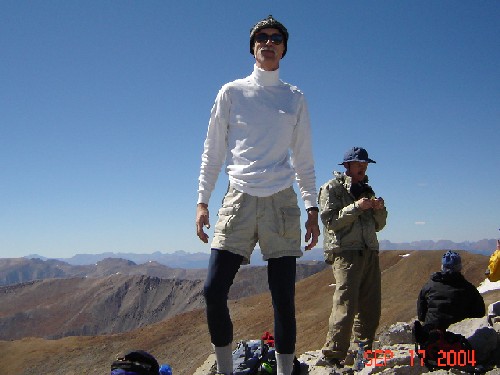23 March, 2007. I had rescheduled my usual Thursday run with the dogs, Buddy and Molly, to a Friday. One result was that I got out fairly early, and I had the option to go for a significantly longer run than usual. So I did.
After considering a couple of other options in the same general area, I decided to bag another of the minor peaks overlooking North Cheyenne Cañon. From the collapsed Tunnel #3, itâ's pretty much a straight shot up the ridge, west and southwest, to unnanamed point 9,413. I had looked at it and considered attacking it several times before, but always put it by for another day. I decided that another day had come.
It took us only 15 minutes to reach the tunnel from the trailhead. I guess it's about a mile (I've never had the presence of mind to measure it accurately), and one gains a couple of hundred feet. From there, instead of following the trail south, we turned west and up the ridge.
From the very beginning, I found wisps of trail running more or less along the ridge crest. It was impossible to tell whether they were climber's trails or merely game trails, as they were all faint, but it was easy to steer a path near the crest and up through the sparse forest.
At the bottom, the forest floor was mostly carpeted with pine needles, and free of snow. After climbing a few hundred feet, however, I began to encounter small patches of unmelted snow. As I approached the first major rock outcropping, areas of open scree also showed up. Coming out into the first large open area of scree, I could clearly see previous boot prints angling up toward the rocks visible from below.
Past the rocks--which afforded a good view of the Cañon below and a chance to assess my progress--I re-entered forested slopes. I also began to encounter patches of snow extensive enough that they could not be entirely avoided. I tried to keep working my way to the left, on the south side of the ridge crest, in hopes of keeping this to a minimum. However, I usually found that the slope made moving to the right, and onto shadier north-facing areas, more appealing.
Eventually, I found myself approaching a saddle, which looked to be basically free of snow. Upon reaching it, I turned right (north), hoping that the high point visible there was the true summit. It wasn't. I could clearly see from there that the slope continued a good distance up to the southwest. This had to be the bump of a false summit clearly visible from below, and I decided to top out on it on the way down, but to press on for the time being to reach the actual top as soon as possible. When I left the trail, I had hoped it would only take me 30 to 45 minutes to make the climb.
The final stretch to the summit, however, was necessarily on north-facing slopes, and involved some postholing in deep and softened snow. There were also patches of snow which I could walk over, but the amount of snow did slow me down.
Finally, however, I reached the rocks of the true summit. The ridge is quite narrow here, and levels out, so some horizontal distance still has to be negotiated after climbing up onto the rock outcropping. Here, I finally encountered some scrambling moves which the dogs couldn't do. They waited patiently for me (but not without a little whining) while I picked my way over to the highest point and took a couple of pictures. Except to the east, the view from this point isn't really very spectacular, so I only took a few. And since the dogs were waiting for me, I didn't take the time to set up the camera for a shutter-delay picture of myself, settling instead for a boot-and-GPS shot to record the altitude. Although the topo map says 9,413, my unit recorded 9,447.
I headed back down, and took pictures of the dogs at the first open space I could find. I also took some much better pictures when we reached the false summit (which only took a few minutes going down). From there, the Cañon below can be seen very well, including our starting point. It also afforded a position from which to get, finally, a decent picture of Mt. Buckhorn and an unusual view of Muscoco Mountain.
We made it back to the car with a total time of two hours and ten minutes, with yet another obscure peak bagged. One of these days, I might try this again, and continue on southwest from the summit, to rejoin the trail to Mt. Rosa above St. Marys Falls. The pictures are at:
http://www.imagestation.com/album/pictures.html?id=2093998735
Long life and many peaks,




